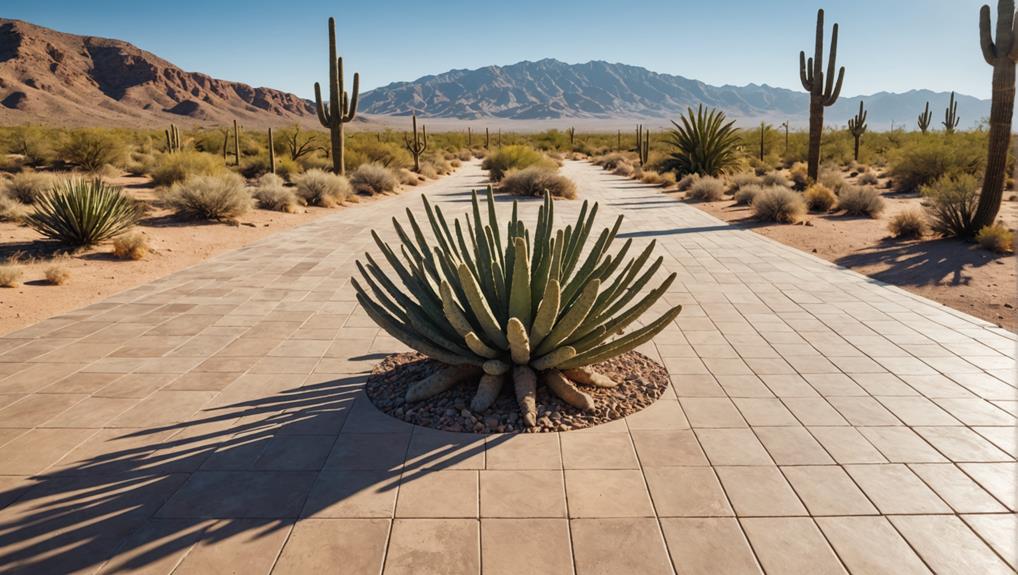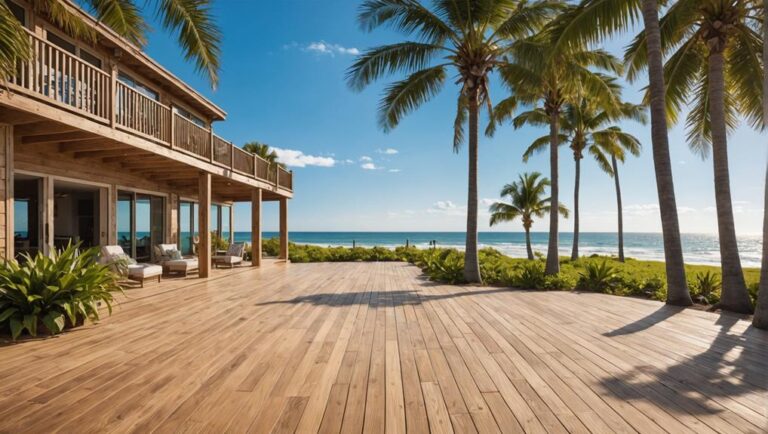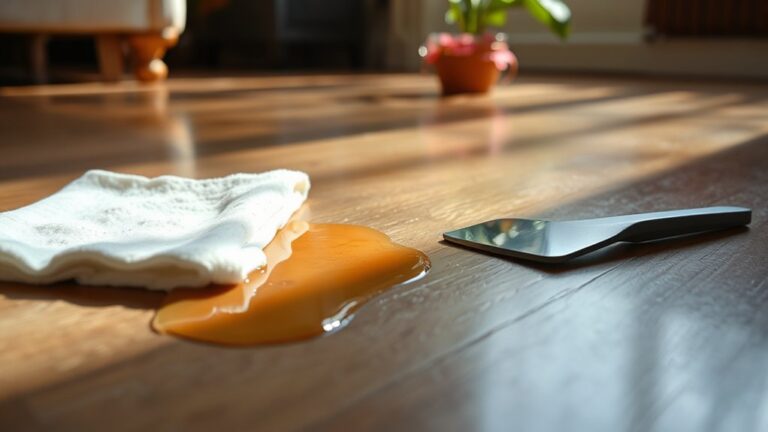When selecting temperature-resistant flooring for desert areas, focus on materials that withstand heat and UV radiation. Options like ceramic tiles, concrete pavers, and natural stone are ideal due to their durability and low maintenance needs. Lighter-colored surfaces reflect heat, enhancing indoor comfort. It's vital to address thermal expansion during installation to prevent warping. Regular cleaning and prompt repairs will extend the lifespan of your flooring. Don't underestimate the importance of choosing the right finish for safety, especially in wet areas. Explore these options further to discover how they can best suit your space and lifestyle.
Understanding Desert Climate Challenges
In a desert climate, extreme temperatures pose significant challenges for flooring materials. High daytime temperatures can lead to excessive heat absorption by flooring, causing potential damage over time. When selecting flooring, it's vital to take into account how different materials react to heat. For instance, darker surfaces tend to absorb more heat, which can make them uncomfortably hot underfoot and may even result in material degradation.
Moreover, the harsh UV radiation in desert environments can deteriorate certain flooring materials, leading to discoloration and weakened structural integrity. This is where UV resistance becomes essential. Flooring options with high UV resistance can withstand prolonged exposure to sunlight without suffering extensive damage. It's important to choose materials specifically designed to endure these conditions, ensuring safety and longevity.
Additionally, fluctuations in temperature can cause expansion and contraction in flooring materials, which may lead to warping or cracking. You'll want to select flooring that can withstand these changes without compromising performance.
Benefits of Temperature-Resistant Flooring
Selecting the right flooring for desert climates not only addresses the immediate challenges posed by extreme temperatures but also offers several long-term benefits. One of the key advantages is energy efficiency. Temperature-resistant flooring can greatly reduce heat absorption during the scorching daytime, helping maintain a cooler indoor environment. This can lower your reliance on air conditioning systems, which not only cuts down energy costs but also contributes to a more sustainable lifestyle.
Another benefit is the aesthetic appeal of temperature-resistant flooring options. With advancements in design and materials, you can achieve a stylish look without compromising on functionality. Whether you prefer the elegance of tile or the warmth of natural stone, there are numerous designs available that can enhance the overall appearance of your space. This aesthetic versatility allows you to create an inviting atmosphere while ensuring durability against the harsh desert conditions.
Moreover, temperature-resistant flooring is engineered to withstand the expansion and contraction caused by extreme temperature fluctuations. This resilience means you're less likely to encounter issues like warping or cracking, ultimately extending the lifespan of your flooring investment. Additionally, many of these materials are designed to be low-maintenance, which saves you time and effort in upkeep.
Top Flooring Materials for Desert Areas
Choosing the right flooring material for desert areas is essential for ensuring comfort and durability in extreme heat. The flooring you select can greatly influence your home's energy efficiency and your overall comfort. Here are some top flooring materials to weigh:
| Flooring Material | Benefits | Ideal Use Cases |
|---|---|---|
| Ceramic Tiles | Highly durable, heat resistant, easy to clean | Kitchens, bathrooms, patios |
| Concrete Pavers | Excellent thermal mass, low maintenance | Driveways, walkways, outdoor areas |
| Natural Stone | Aesthetic appeal, withstands high temperatures | Living areas, entrances |
| Porcelain Tiles | Water-resistant, versatile design options | Indoor and outdoor spaces |
Ceramic tiles are a popular choice due to their ability to absorb and dissipate heat effectively, making them an excellent option for high-temperature environments. Not only are they durable, but they also come in various styles, allowing you to maintain aesthetic appeal without sacrificing safety or comfort.
Concrete pavers are another fantastic option. They provide excellent thermal mass, helping to keep your space cooler during the day. Additionally, their low maintenance requirements make them ideal for outdoor areas where you want to minimize upkeep.
Tips for Choosing the Right Flooring
When evaluating flooring options for your space, it's important to contemplate various factors that affect both functionality and aesthetics. In desert areas, the extreme temperatures can impact your flooring's performance and longevity. Start by identifying the environment where the flooring will be installed. For outdoor areas or spaces with high sunlight exposure, opt for materials specifically designed to withstand heat and UV rays.
Consider color selection carefully. Light-colored flooring tends to reflect heat, helping to keep indoor spaces cooler, while darker shades can absorb heat, potentially raising indoor temperatures. You'll want to guarantee that your color choice harmonizes with your overall design theme while also providing thermal comfort.
Next, think about the installation methods. Some materials require professional installation to guarantee they are laid correctly and can handle the thermal expansion and contraction that occurs in extreme temperatures. For example, tiles and certain laminate flooring options may require specific techniques to prevent warping or cracking. If you're considering DIY installation, make sure you're familiar with the best practices for your chosen flooring type.
Lastly, always prioritize safety. Look for flooring options that have non-slip finishes, especially for areas that may become wet. This will help mitigate the risk of slips and falls, guaranteeing your space remains both beautiful and safe. By taking these factors into account, you'll be better prepared to select the right flooring for your needs.
Maintenance for Long-Lasting Performance
Maintaining temperature-resistant flooring is essential for ensuring its longevity and ideal performance. To achieve this, you'll need to incorporate effective cleaning techniques and be prepared to explore various repair options when necessary. Regular maintenance not only preserves the aesthetic appeal of your flooring but also enhances safety by reducing the risk of slips and falls.
Start with routine cleaning. Use a vacuum or soft broom to remove dirt and debris, which can scratch the surface over time. For deeper cleaning, opt for a pH-balanced cleaner that's suitable for your specific flooring material. Avoid harsh chemicals, as they can damage the finish and compromise safety.
In areas with heavy foot traffic, consider implementing a schedule for professional deep cleaning to address stains and wear more effectively. This is especially beneficial in desert regions where dust accumulation can be significant.
When it comes to repairs, promptly address any scratches, chips, or cracks. Most temperature-resistant flooring materials have specific repair options, such as patch kits or sealants that can be applied easily. Familiarize yourself with these products, as timely repairs can prevent further damage and extend the life of the flooring.
Frequently Asked Questions
What Is the Typical Lifespan of Temperature-Resistant Flooring?
The typical lifespan of temperature-resistant flooring can vary considerably based on durability factors like material quality and installation methods. Generally, you can expect a lifespan of 15 to 30 years. To maximize this lifespan, follow maintenance tips such as regular cleaning and avoiding harsh chemicals. Additionally, guarantee proper ventilation to prevent moisture buildup. By focusing on these aspects, you'll enhance both safety and longevity, making sure your flooring remains effective over time.
How Do I Install Temperature-Resistant Flooring Myself?
To install temperature-resistant flooring yourself, start by gathering the necessary flooring materials, including adhesive and tools. Verify your surface is clean and level before beginning installation. Follow the manufacturer's guidelines for the specific product you're using. Use installation tips like staggered seams for stability and proper spacing to allow for expansion. Always wear safety gear and verify proper ventilation during the process for a safe and effective installation.
Are There Eco-Friendly Options for Temperature-Resistant Flooring?
Yes, there are eco-friendly options for temperature-resistant flooring. You can choose sustainable materials like bamboo, cork, or recycled rubber, which provide durability while minimizing environmental impact. When considering installation, verify proper subfloor preparation to enhance performance and longevity. Use non-toxic adhesives to maintain a safe indoor air quality. For installation tips, follow the manufacturer's guidelines closely, and consider acclimating your chosen material to the environment before installation for ideal results.
Can Temperature-Resistant Flooring Help With Home Cooling Costs?
Yes, temperature-resistant flooring can markedly reduce home cooling costs. By enhancing energy efficiency, these materials offer insulation benefits that keep your living space cooler. They reflect heat, preventing it from penetrating your home, which means your air conditioning system won't have to work as hard. This not only saves you money on energy bills but also extends the lifespan of your HVAC system, ensuring a safer and more comfortable environment for you.
What Is the Cost Range for Temperature-Resistant Flooring Materials?
You might be surprised to learn that the cost range for temperature-resistant flooring materials can vary quite a bit. Depending on your chosen installation techniques, you could spend anywhere from $3 to $10 per square foot. Material comparisons show that options like porcelain tiles or specialized vinyl offer durability but differ in pricing. Investing wisely in these materials not only enhances safety but can lead to long-term savings on cooling costs.




